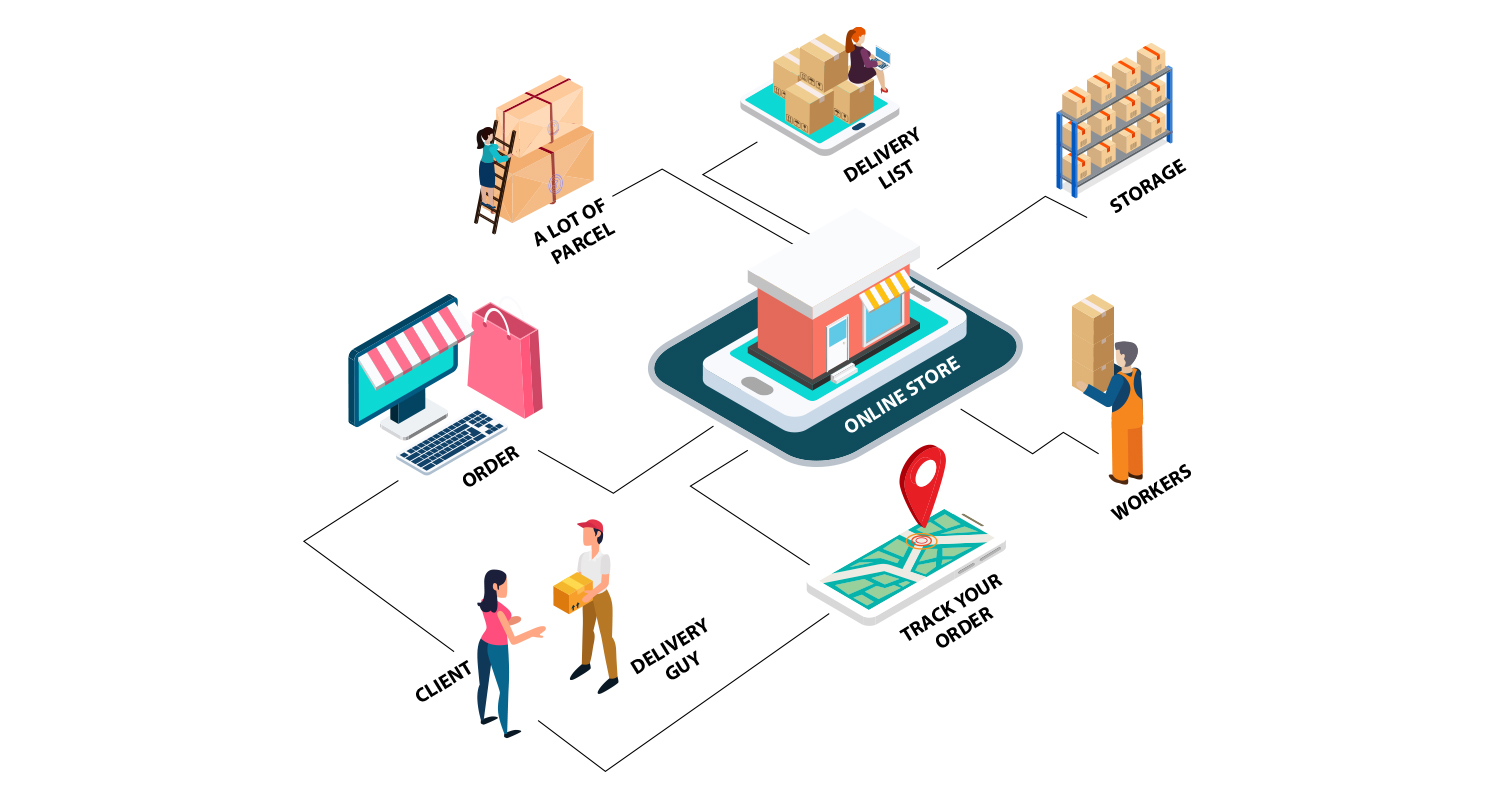Perspective of Supply Chain Management in the E-Commerce Era
Table of Contents

Supply chain management (SCMs) is the backbone of the e-commerce sector. It helps establish a chain of systems that starts with the user placing an order, processing it, and ending in its successful delivery. This highly coordinated strategy, aided by modern technology, ensures a seamless online shopping experience. Now, the rapid evolution of online shopping is demanding individuals who are well-versed in the fusion of supply chain management and e-commerce and who can establish a smooth function that helps the business grow and keep customers satisfied.
This write-up explores the intricate relationship between supply chain management and e-commerce and the career opportunities available in this sector.

*cmarix.com
Supply Chain Management and E-Commerce: Working Together
The role of SCM in e-commerce is to enable and ensure smooth navigation of products from the suppliers to the customers. Here is how supply chain management and e-commerce work together –
- Inventory management
Inventory management operations include managing and tracking inventory levels. For instance, it requires tracking sales data, monitoring and tracking stock levels, and analyzing historical trends. Also, by integrating inventory management systems, the e-commerce brands automate these processes that ensure the products are available at the right time. As a result, the brands can meet customer demand without fail.
- Warehouse and distribution
The products are preserved in the fulfillment centers or warehouses. The warehouse management systems facilitate order fulfillment, inventory tracking, and storage. So, when a customer orders a product, the software notifies the warehouse personnel. They pick up the product from the warehouse, pack the product, and make it ready for shipping.
- Processing the order information
When the customer places an order, the supply chain management system in e-commerce processes the order information. It will check the products’ availability, verify and validate the customer’s details, check payment and customer’s details, and inform the customer about the expected date of delivery.
Moreover, the order processing system has additional features such as address verification, order prioritization based upon SLAs (service level agreements), and fraud detection. This way, supply chain management and e-commerce brands process orders together.
- Transportation of orders
Next, the SCM systems process the transportation of the orders. It includes selecting proper carriers for the orders, identifying the shipping mode (road, water, or air), and producing the shipping labels.
After shipping the orders, the system will notify customers and share real-time tracking information. So the customers can monitor the shipping progress of their orders regularly.
- Successful order delivery
The final step in SCM in e-commerce is customer order delivery. A successful order delivery includes managing logistics, coordinating with the carriers, and optimizing the delivery routes. Finally, the system should ensure the delivery of the customers on time and with the right order.
How to Design an Effective Supply Chain Management and E-Commerce?
When establishing an effective SCM in e-commerce, individuals should use several strategies to make their ongoing operations more feasible. Here are some examples –
- Examine the current supply chain
It doesn’t matter whether an individual is an experienced omnichannel or single-channel retailer; they should re-evaluate their supply chain strategies. By adopting this approach, the retailers can detect which of their vendors cause product delays or bottlenecks. This way, they can understand which areas of their supply chain have flaws. Accordingly, they can develop strategies to remove those issues. This way, the company benefits from the refined strategies of the supply chain workflows.
- Reduce shipping costs and delivery times
One of the most significant challenges in supply chain management and e-commerce is meeting customers’ expectations without incurring additional costs. According to Amazon, customers always expect faster delivery. But that should not come at an extra cost for the company.
So, the idea behind developing a new strategy should be to lower this cost as much as possible. Companies offer free delivery as it helps establish a good relationship with the customer, but they should ensure they are not paying for it out of their pocket. With the right SCM strategy, they can achieve that.
- Reshape the workforce management strategy
Most of the e-commerce brands across the globe still rely on manual labor, and this expense rises as the company grows and employs more people. So, improving ROI with automation in supply chain management and e-commerce will be an excellent plan.
Besides, retailers should manage their employees strategically. The employees should be trained for productivity improvement and efficient time management. This way, they can create a better-managed and efficient workforce. As a result, it will enhance the order-filling rate and reduce the cost per order (CPO).
Moreover, retailers of brick-and-mortar stores can maximize their in-store labor by implementing this strategy and boosting inventory management. It will also increase their inventory turnover.
- Picking up more orders simultaneously
It’s essential to pick up the orders for the order fulfillment process for successful supply chain management and e-commerce workflows. It also requires the retrieval of products from warehouses and inventory spaces. However, the order picking must be done in the right way, including all the stages from packing to post-sales procedures.
So, if a brand can pick up multiple orders simultaneously, it will be a more time-saving approach for the brand. As a result, their shipment will be faster. Ultimately, it will streamline the customer experience. Finally, an improved customer experience will drive more revenue, both in the long term and short term.
- Using technologies to reduce processing time
Barcode technology has become a boon for warehouse logistic operations. Barcode labels and scanners enable e-commerce stores to track who, when, and what activities are currently going. It increases accuracy and credibility in the logistic operations. Thus, barcodes reduce the time for order receiving, returning, and replacement, making it an integral part of any supply chain management and e-commerce strategy.
- Integrate advanced software solutions
Cutting-edge software solutions such as order management systems (OMS) or enterprise resource planning (ERP) can revitalize the supply chain management system or e-commerce. The OMS offers automation to streamline the workflows in the supply chain, optimize the operations, and provide cost-saving solutions.
Additionally, the inventory management software (IMS) offers real-time data analysis that helps maintain accuracy in reordering processes and inventory control.
- Partnership with third-party logistics provider
A partnership with a third-party logistics (3PL) provider becomes beneficial when the stores don’t have enough funds to manage their own fulfillment center. The brands can connect with an extended supply chain network by adopting this strategy. It improves order fulfillment and enables accessing numerous teams of experts. This way, the brands can improve their supply chain management and e-commerce strategies and develop a growth mindset.
- Boost customer communication
Enabling consistent communication is the key to successful supply chain management and e-commerce. This consistency should be maintained throughout the entire customer journey. It includes sending order placement, processing, order tracking, shipping, expected delivery date, out for delivery, and ‘delivered’ notifications through SMS, email, or in-app. As a result, it will reduce the contact cost of customers with significantly fewer inquiries. Ultimately, it will increase customer satisfaction.
Benefits of Appending Supply Chain Management and E-Commerce
A solid SCM strategy will take an e-commerce brand to the next level. It ensures that the users get the right and quality products on time at reasonable prices. Therefore, supply chain management and e-commerce ensure that customers have the best possible experience. Here are all the benefits –
- Cost reduction
E-commerce is a huge and complex market that includes costs and different procedures. For instance, development, promotions, marketing, inventory management, and distribution require a certain amount of money. So, by integrating SCM in e-commerce, companies can dilute unnecessary financial burdens and improve ROI.
- Enhance quality control
Supply chain management and e-commerce conduct quality control in a better way. It allows the brands to monitor the shipments properly. Moreover, it supports contacting the suppliers in case of any issue during production or shipment. This approach ensures the products’ quality is maintained from beginning to end, from production to delivery.
- Better inventory management
Supply chain management and ecommerce disavow the malpractices like understocking or overstocking in inventory management. The SCM system monitors how much stock is available for a particular location after every order, reducing the chance of overstock or understock. This way, it maintains a standard level of product stock.
- Revamped delivery time
The SCM systems help to predict the estimated delivery time for the customers. Thus, instead of the guesswork, customers can know their delivery time. So, it helps them to provide almost accurate information about the delivery. This way, supply chain management and ecommerce assist in predicting delivery time.
- Refined communication between employees
E-commerce brands must have their own communication platform that ensures proper communication between employees. As a result, everyone remains informed about their responsibilities and gets every work update.

*qodenext.com
Career Opportunities in Supply Chain Management and E-Commerce
Here are some roles involved in SCM and e-commerce –
- Supply chain manager: The supply chain managers ensure that all steps involved in this system should be managed flawlessly. These include the production and distribution of the items.
- E-commerce operations manager: They supervise the smooth online retailing processes and regular operations.
- Inventory analyst: The professionals involved in these roles become responsible for predicting demands, identifying trends, and making informed decisions accordingly.
- Reverse logistics specialist: They are responsible for handling the backward flow of the products. That indicates the return of the products, recycling, repair, and maintenance.
Real World Applications of SCM in E-Commerce
Here are some real-world examples of how e-commerce brands are implementing the best practices of SCM –
- Amazon’s inventory tracking
The warehouse workers of e-commerce giant Amazon use a handheld device to scan the products that come in. The device helps to automate the manual data entry process. This way, the company can track inventory levels at all times. As a result, there is no gap between the products’ arrival and sale.
- Alibaba’s supply chain monitoring
Alibaba has an excellent strategy for predicting its customers’ behaviors. They use big data analytics to monitor supply chains, revealing historical data and the latest market trends. It helps them to understand users’ behaviors in advance and make decisions accordingly.
This way, data analytics in supply chain management and e-commerce revitalize service quality. Also, it helps the brands to reach new markets.
- Walmart’s food product tracking with blockchain
Walmart uses blockchain technology to track food products. It assists them in informing the users about where the foods come from and what is inside the packages.
According to Harvard Business Review, DL Freight, the blockchain network created by Walmart Canada, became successful in reducing their invoice disputes from 70% to less than 1%, significantly. Thus, blockchain technology has become an excellent tool for lowering discrepancies in supply chain management and e-commerce.
Head Over to a Professional Course on Supply Chain Management and E-Commerce
Supply chain management and e-commerce offer excellent possibilities and demanding career opportunities for students. So, head over to the Advanced Certificate Programme in Smart Supply Chain Management & Transformation IIM Kozhikode and take your SCM and e-commerce career to the next level. After taking this course, the students will learn to manage complex challenges in a global supply chain scenario and adapt better decision-making capability for SCM. The major KPIs of this course are –
- Hands-on training with data
- Live projects
- Case study
- Excellent lectures
- 2 campus immersion modules
- Certification on completion
You will be able to find this SCM course on the website of Jaro Education, along with a host of other courses that can help you upskill and take your career to newer heights.
Conclusion
Supply chain management and e-commerce become undividable from each other. The other becomes meaningless in the absence of one. SCM ensures that e-commerce brands operate successfully and navigate through their everyday challenges. Therefore, by implementing proper SCM strategies, the businesses stand out and remain competitive in the market.
Frequently Asked Questions
What is supply chain management in e-commerce?
SCM in e-commerce ensures a flawless transition from one step to another by minimizing costs and maximizing customer satisfaction.
State the role of SCM in B2B e-commerce.
SCM in B2B e-commerce revolutionizes inventory management through real-time tracking and data insights.
What is a CRM in e-commerce?
CRM or customer relationship management indicates the practices, strategies, and technologies to manage customer interaction throughout the customer lifecycle with an aim to drive sales.








![Journalism-and-Mass-Communication-Salary-in-India-in-2025-[Average-to-Highest]](https://jaro-website.s3.ap-south-1.amazonaws.com/2025/10/Journalism-and-Mass-Communication-Salary-in-India-in-2025-Average-to-Highest-1024x576.webp)









